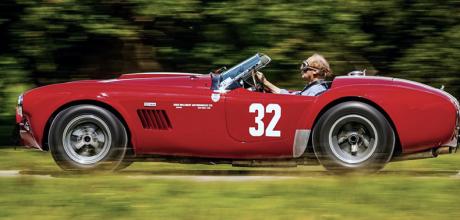1963 AC Cobra factory racer
This AC took the Cobra’s first class victory at Le Mans before winning of one of the most memorable showdowns in GT history. Today Ivan Ostroff reacquaints himself with 39 PH.
Photography TONY BAKER
Le Mans Cobra on the road!
Firing up AC’sfirst – and mostcontroversial – winning Cobra
Once Bitten, Forever Smitten Driving 39PH, the first AC Cobra to win at Le Mans
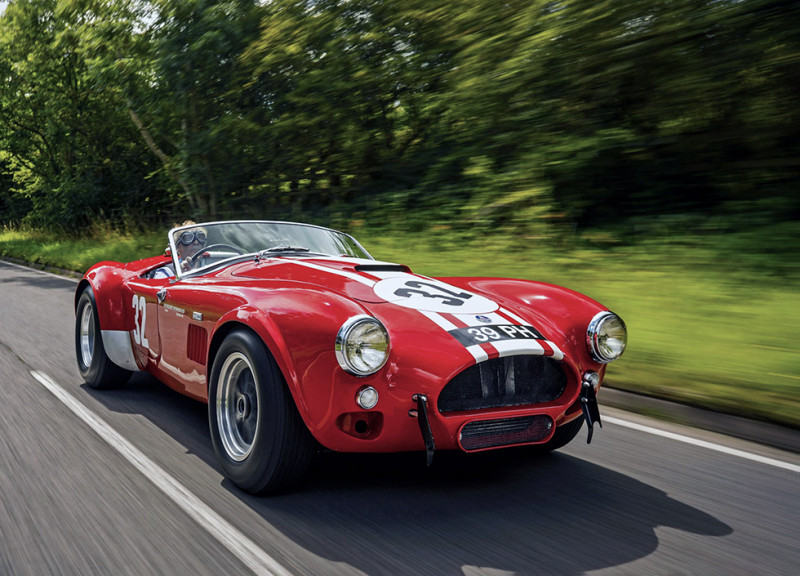
It’s not the first time I’ve driven this car, but still I’m hit by a shiver of anticipation as I approach it. The chassis number, CSX2131, would immediately tell Cobra anoraks why; the registration it wears, 39 PH, might by extension rile up a fan of golden-era GT racing. But for the un-doctrinated, allow me to explain. This car wasn’t only a class-winner at Le Mans – and the highest-place open Cobra ever to race there – but it was also Jack Sears’ triumphant steed for the legendary ‘Black Flag Race’ at Brands Hatch in 1964, possibly the most memorable sports car battle of all time. Ultimately, this is arguably the most special Cobra in the world. And today, I’ll once again take advantage of its road-legality and drive it on the public highway. There’s another tingle of trepidation…
Today the car wears its Willment Racing colours of red with white stripes over its curvaceous FIA bodywork. It’s a stunner, and the cut-down, raked-back windscreen Willment gave it lends it a hot-roddish appeal that only enhances the Cobra’s trademark masculinity. The huge aluminium fuel filler cap sited behind the driver marks it out as a racer; it also retains the quick-lift jacking points it was fitted with in period.
I open the cutaway driver’s door and slide down into the hot seat. A taller man would have his head well-exposed by the raked windscreen, but being of modest stature that doesn't affect me. I latch up the full Simpson racing harness and pull my goggles down from my forehead. A twist of the ignition key and the air erupts with a thunderous bellow from the 4.7-litre Ford Hi-Po V8 before it settles into a fast, smooth tick over.
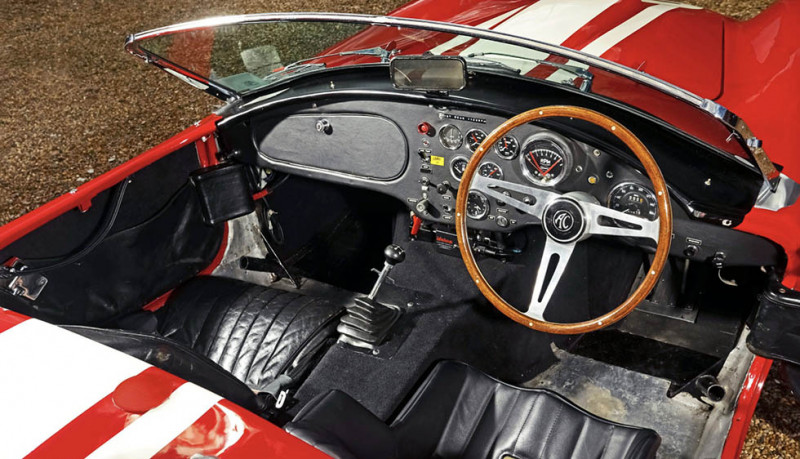
This car was originally ordered from the AC factory at Thames Ditton by American Ed Hugus, specifically to enter in the 1963 Le Mans 24hr race. Hugus was a gentleman racer, car importer and Ford dealer who had been helping Carroll Shelby import Cobras into the USA. In fact, he completed the first nine of them in his East Coast workshop, so was familiar with the car. However, he insisted that neither Carroll Shelby nor Ford Motor Company would have any input in the build of this one – it was to be built strictly to his instructions. In fact, he sent AC an 11-page list of modifications he felt essential if the car were to survive racing for 24 gruelling hours. For example, Hugus doubted that the usual wire wheels would last the race so had Dunlop magnesium one-piece items fitted instead.
Hugus had originally planned on fitting a tuned 260ci (4.3-litre) Ford V8 but Ford was more than happy that the Cobra would be running at Le Mans and provided some specially prepared 289cu Hi-Po engines for CSX2131 and the two other intended factory racers AC decided to construct alongside it; only one was completed in time for Le Mans. The V8 fitted to this car produced 330bhp and was fed by four twin-choke Weber IDA carburettors. It was the tall profile of the Weber-crowned engine that led to AC fitting the raised bonnet scoop, which subsequently became the norm for all competition Cobras.
I wait while the Hi-Po (short for high-performance) V8 gets up to temperature, taking in my surroundings. The dashboard is fully equipped with a triangular cluster of minor gauges, plus an unusual large 8000rpm Rotunda tachometer sitting to the left of the steering column, clearly visible through the aluminium spokes of the woodrim steering wheel; a speedometer sits unsymmetrically lower to the right, and shows 180mph.
The Cobra’s inherent aerodynamic profile is certainly not the slippiest so it tops out around 145mph. But 39 PH was one of a handful of racers factory-fitted with a removable streamlined fastback hardtop, specially made in ultra-thin lightweight aluminium by Brownlow Metal Co, a subsidiary of AC. Soequipped, this Cobra could hit 167mph on the Mulsanne, which made it more competitive in the GT class. It also made the car extremely noisy inside, but at least it provided the additional benefit of protection against wind and rain.
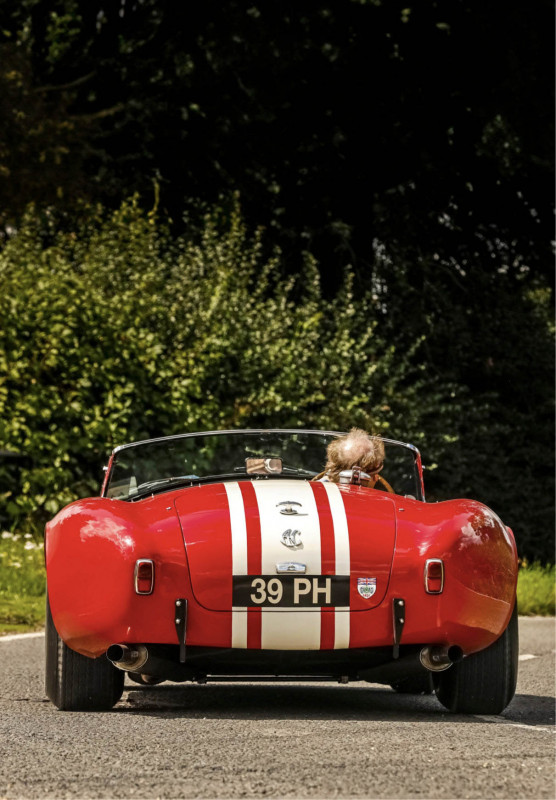
I’m afforded no such luxury today; the car takes the roadster form of its post-Le Mans days. I dip the heavy clutch then lift the T-bar on the BorgWarner T10’s stubby gear lever to engage reverse, before snicking into first and pulling away. On the move, it’s a pleasant transmission. Of course it’s not as fast a change as would be found in a small-motor screamer, but once the oils are warmed through the pudding can be stirred with satisfying gusto. The synchromesh is perfectly effective, but it’s amazing how some heel and toe and double de-clutching down through the T10 can effect such quick changes. Conversely, with the immense V8 torque available, even on this race-tuned unit, it’s easy to cruise through the countryside in top should you just want to take in the scenery at leisure. But hey, this is a Cobra. The all-round disc brakes offer plenty of progressive feel from the off, and now warmed up they work exceptionally well.
Unable to resist flooring it in first gear, I gasp as the needle arcs around the Rotunda in a flash, the exhaust growls through a large pipe at each rear corner and the four huge Webers make colossal intake roar. Pushed well back into my seat, I grab the lever and whip it back; there’s no time to look at the speedometer given its peripheral location, but I know that I’ve probably just hit sixty miles per hour in well under five seconds. That sort of performance is eminently respectable today; astonishing for a car built in 1963. I ease off in the interests of law and order but wow, it’s impressive, made all the more visceral for my unimpeded exposure to the atmosphere.
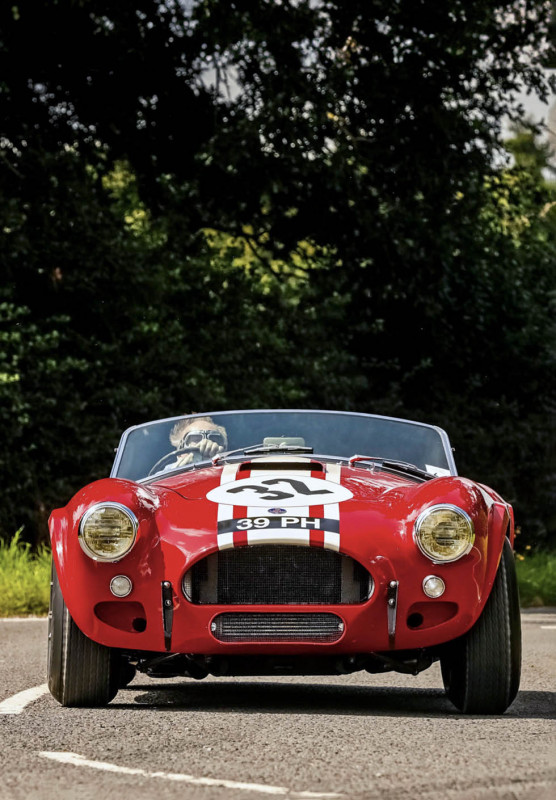
The suspension feels crashy, probably because the car has been set up primarily for the track over the last few years. There is little perceptible roll and the handling works well. A Cobra does tend to suffer initial turn-in understeer, so going into a long sweeping corner, I bring the tail out by lifting off briefly then putting power down, the rear end shimmying as the car rotates. Under power, the Dunlop L tyres allow 39 PH to slide controllably and feel very neutral. It’s progressive and rather easy to manage, and I soon recall the car’s warm reception to a power-through driving style. This car does not get itself into raucous angles easily, but it doesn’t take much coaxing if that’s your aim. The trick is to get it set up into the corner then control it on the throttle. As it slides, it feels evenly balanced front and back. The steering is remarkably light, almost like having servo assistance, but the rack is responsive and quick and I can feel what is happening to those Dunlops constantly.
With a peak 420bhp at 6600rpm and 365lb ft at 5000rpm these days, there is so much grunt. That, combined with an axle ratio of 3.73:1, means no matter what gear I’m in, or how many revs are on the tachometer, it always remains tractable. On hard acceleration, the exhaust snarls with the deepest growl, becoming a higher scream as the needle spools through four, then five thousand rpm. The noise is an absolute adrenalin rush and the car wills you to keep your foot down. I know that owner Kevin Kivlochan pulls 6500 down Lavant Straight at Goodwood, but sadly there’s no chance of trying that on the road.
For the car’s tilt at Le Mans, AC flared the wheelarches, but the wide 6x15 front and 7x15 rear Dunlop racing tyres still protruded, so additional metal spats were fitted to comply with regulations. The car was ready just in time, painted in AC racing colours of Moss Green and legally registered for the road with the number 39 PH. It was driven from Thames Ditton to Le Mans by AC chairman Derek Hurlock whom, according to the official race programme, had entered the car. The Sunday Times provided a certain amount of sponsorship and Innes Ireland attended the race on the newspaper’s behalf. He appointed Stirling Moss as team manager – this was the year after the Goodwood crash had ended his racing career – while the drivers were Peter Bolton and Ninian Sanderson.
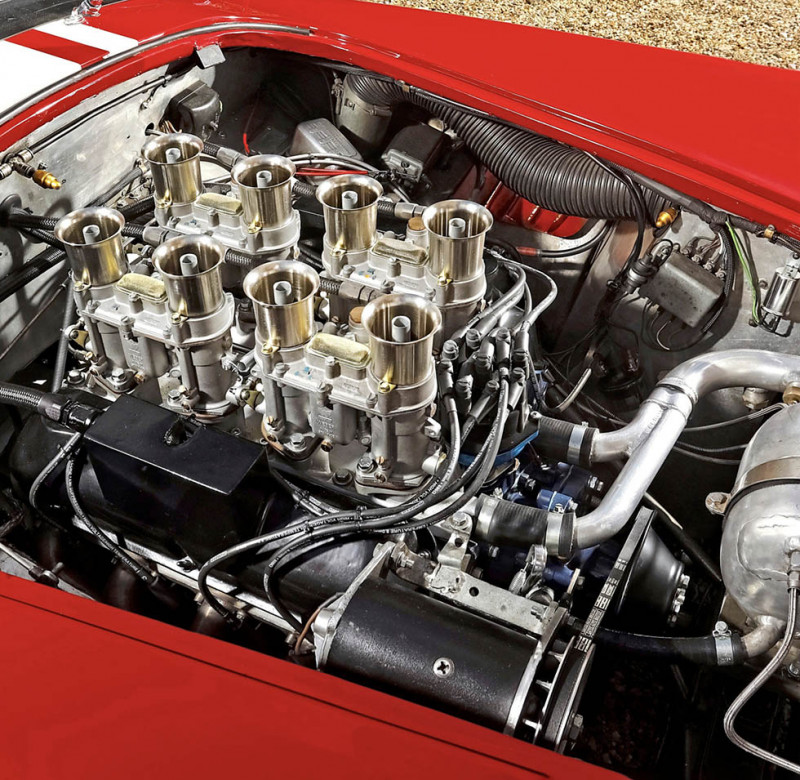
There was a nasty accident early on in the race caused by oil on the track, but luckily 39 PH managed to avoid the carnage.
A second works Cobra, chassis CSX2142, driven by Hugus and Peter Jopp, suffered an oil leak and was subsequently disqualified after 117 laps for stopping to take on oil at an unspecified time. By the halfway mark, 39 PH was up in tenth place overall. When the chequered flag fell at 4pm on 16 June, Ferraris filled the first six places, followed by 39 PH in seventh overall. It had won the GT +3000 class – where it squared up against the likes of Briggs Cunningham’s Lightweight E-type and Aston Martin DP214 – completing 310 laps at a 108mph average. Not bad considering there had been no opportunity for pre-race development whatsoever. After the race, Hurlock simply drove 39 PH back to Thames Ditton without incident.
Eleven days later the car was at the MIRA track being tested by Motor magazine. Still fitted with its worn, flat-spotted racing rubber, it managed 0-60mph in less than five seconds, 0-120mph in 12 seconds and a top speed of 139.6mph at 6200rpm, with an axle ratio of 3.77:1. It was subsequently invoiced to Willment Racing for $4000, along with chassis CSX2142 and CSX2130. The three cars were then prepared for the 1964 racing season under the supervision of team manager Jeff Uren. During the winter, 39 PH was repainted in the Willment colours of red with white stripes. In readiness for shorter circuit races the hardtop was removed and the rear-exiting exhausts were replaced with side pipes. Jack Sears had a new contract with Willment for 1964 and was ultra competitive from the off, bringing 39 PH home in second place in the Sussex Trophy at Goodwood, less than a second behind Graham Hill's Ferrari 250GTO.
Both Jack Sears and Bob Olthoff complained that the Cobra handled poorly. When Shelby’s advice was sought, apparently the reply was, ‘ain’t nothing wrong with the goddamn car, it’s the driver’ – and he promptly sent Ken Miles over from the USA to ‘show them how to drive it’. Miles jumped into 39 PH for the first time at Brands Hatch, shot out of the pit lane and went straight off at Paddock Hill Bend. Miles called Shelby and insisted he sent over some Halibrand wheels and Goodyear rubber to replace the special-order magnesium Dunlops.
The wheelarches on 39 PH were widened further to accommodate the Halibrands and at Oulton Park on 11 April, the windscreen was also slanted further back to reduce drag. Although strangely, this was not picked up by the scrutineers – probably because prior to and immediately after the race, the screen miraculously appeared to be in its standard position. Sears won his class and was second overall behind Jim Clark’s Lotus 19. The following week at Aintree it was a similar story. At the Nürburgring 1000km on 31 May, 39 PH was to be shared between Sears and Frank Gardner, who spun and rolled it into a ditch during practice. During repairs back at the Willment workshop, the opportunity was taken to fit the FIA-style cutback doors and flared rear wings it wears today, making it easier for the car to accommodate wider wheels. On 11 July, 39 PH was entered in the 20-lap support race for the 1964 British Grand Prix at Brands Hatch – the Ilford Trophy. This race has become known as ‘The Black Flag Race’ and has gone into racing mythology (see page 84). It is even fully described in Maurice Hamilton’s book British Grand Prix.
In 1965, D & A Shells & Chassis of London bought the car from Willment, then in August 1967 sold it on to Gerry Bagshaw. Bagshaw competed in several club events before damaging it at Crystal Palace in 1969. The forlorn Cobra lay in his garage until 1973 when it was bought by Ron Stern, who roughly repaired and resold it the next month to Dennis Hulme and his son Nigel. ‘It was very tired,’ Nigel recalls. ‘There was just one seat in it and the engine had the cylinder heads off, so I decided that I would rebuild it. l took the body off, stripped the chassis and delivered the engine to Mathwall Engineering. I said it would be used as a road car so it was rebuilt with a milder cam, and the Weber carbs were replaced with a Holley to make it more useable. The front end of the chassis had been damaged when Bagshaw crashed it, so Nigel had it repaired, declining the offer of a new chassis. It was then sent to the British Rail workshop at Swindon, where it was shot blasted and stove enamelled. The front suspension components were cleaned, straightened and then cadmium plated. ‘I did the rebuild myself, it was just a labour of love,’ recalls Nigel. ‘I even made an exact copy of the wiring loom on the bedroom floor in my flat.’

He managed to get hold of the original Le Mans fastback hard-top, which Bagshaw had kept. It was made of paper-thin aluminium, so Nigel skimmed the inside with GRP for strength. ‘Initially I’d painted the car Peugeot China Red. When I acquired the hardtop in Willment red with white stripes I realised the car was the wrong shade, so repainted it correctly.’ Over the next 30 years Nigel enjoyed 39 PH at various concours events, sprinting it at Brighton and racing it in the Goodwood Revival TT.
In 2002, 39 PH was bought by Jon Minshaw of Demon Tweeks, then in 2009, by Nigel Corner, who sold it to Sir Paul Vestey. While in Vestey’s ownership the car took part in the 2012 Revival and the Festival of Speed in 2012 and 2015. In 2017 39 PH was sold through Duncan Hamilton to Gregor Fisken who prepared the car to race competitively again at the Revival; sharing with Dario Franchitti, he placed sixth in the TT in 2021. It was entered in the TT again the following year but was shunted and retired. Its current owner, Kevin Kivlochan, took the car over in 2022.
I trundle the car back up Kevin’s drive, blip the throttle to clear the plugs and switch off the ignition. Another memorable day with 39 PH has left me grinning ear to ear. I think back to the first time I drove the car, shortly after the 1999 Goodwood Revival, cruising along a leafy Sussex B-road with Nigel Hulme sitting next to me in the passenger seat. There was a procession of four or five cars ahead. I glanced at Nigel and he nodded. I dropped her into third and overtook the complete row in one fell swoop. The power was astonishing, the Weber-led soundtrack reverberating through the trees haunting. I’d defy anyone not to be captivated, exhilarated, and probably a little intimidated. ‘You dug your heels in and then you just hung on,’ said Sears. ‘It was a muscle car, not a good handling car, you simply had to be brave. Racing a Cobra was like riding a bucking bronco.’ Yet Sears forged a close relationship with 39 PH, his sidekick for the drive of his life. In a 1980 interview, Sears recalled, ‘That particular car and myself were good friends. We never went off the road and never crashed, and only once had mechanical trouble. It was a fun motor car.’
Having built my own relationship with 39 PH, I concur.
TECHNICAL DATA 1963 AC Cobra factory racer
- Engine 4727cc (289ci) V8, ohv, four Weber 48IDA carburettors
- Max Power 420bhp @ 6600rpm
- Max Torque 365lb ft @ 5200rpm
- Transmission Four-speed manual, rear-wheel drive, limited-slip differential
- Steering Rack and pinion
- Suspension Front and rear: independent, transverse leaf spring and wishbones, telescopic dampers
- Brakes Discs all round
- Performance Top speed: 167mph
- Acceleration 0-60mph: 4.8sec
- Cost new £2732 4s 9d
- Classic Cars Price Guide £550k-£900k (standard AC Cobra 289)
OWNING 39 PH
‘It’s rather hard to get it through my head that I own it,’ says Kev Kivlochan. ‘I always dreamed of owning 39 PH and going to Rétromobile in Paris, so after I bought it, we made a booking at Moulin Rouge and had a meal on top of the Eiffel Tower with my wife and while we were there, I was able to visit Rétromobile. It really is a privilege to own this car. ‘Richard Walbyoff at RW Racing maintains it for me and the engine is being refreshed by Peter Knight.
Gregor Fisken had the car set up rather hard for racing, so Richard will probably change the roll bars and soften the double-adjustable Koni dampers so that it will be more comfortable and practical on the road. We will also put the windscreen back to standard rake so that that hardtop can be fitted when required. It was raked back so far when I bought it, that my eyeline was above it and my head would hit it.
‘I might well enter it into the occasional historic race and would love to take it to events like Monterey. It doesn’t matter if it wins or not, it’s important the car is seen. It will be definitely be used on the road and certainly taken down to the pub.’


